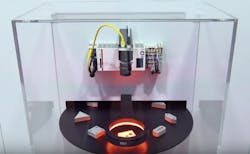The Integration of Vision and Control
Vision technologies have long been of great interest to manufacturers for use in everything from assembly to sorting and packaging to quality. Historically, the biggest drawback to vision systems were their cost and complexity. Over the past decade, vision technology suppliers have addressed both of those issues, with costs coming down dramatically and programming getting much simpler.
But the process of integrating vision into an automation system has remained a more complex task. Though the simplification of vision system programming has made this integration process simpler, it still requires a certain level of expertise.
To address this, Beckhoff has incorporated image processing capabilities into its PC-based control system with the release of its TwinCAT Vision software, which was highlighted at the SPS/IPC/Drives show in Nuremberg this fall. According to Beckhoff, this new software release “unites a comprehensive range of machine functionality—PLC, motion control, robotics, high-end measurement technology, IoT (Internet of Things), HMI and machine vision—all in an end-to-end engineering and control platform. With this level of integration, TwinCAT Vision eliminates the need for separate vision solutions, often developed by third parties. The software opens up vast innovation potential in machine building; for instance, through consistent real-time synchronization with other automation tasks or support of advanced track-and-trace solutions.”
In essence, with TwinCAT Vision, Beckhoff is working to simplify the process of vision system integration by removing the need for specialized tools or programming languages to code the image processing logic. Beckhoff says it achieves this simplification by enabling the machine vision applications to be created in the PLC “using familiar PLC programming languages…meaning that PLC programmers can now create machine vision applications themselves without support from outside experts.”
By integrating control and vision into TwinCAT Vision, the software can provide the required image processing capabilities in the form of PLC functionality with a library of image processing functions and function blocks that can be called up from the TwinCAT PLC. Beckhoff notes that the flexible runtime system in TwinCAT is capable of executing these functions and function blocks in real time.
Cameras of almost any kind that comply with GigE Vision (a vision interface standard introduced in 2006) are said to be operable with TwinCAT Vision. Beckhoff adds that multiple cameras can be made to work in parallel via standard camera interfaces configured in TwinCAT Engineering. The cameras can also be calibrated directly, either in the engineering environment or mid-process in the runtime system.
The TwinCAT Vision software also addresses the network bandwidth issues often created by the incorporation of vision systems. Beckhoff claims that TwinCAT Vision not only avoids communication problems between image processing and control applications through its integration of the technologies, it also mitigates external factors such as those caused by operating system impacts on processing times and data transmission speeds. The software is able to do this because it also allows the image processing and control components to communicate with one another directly. “Because the image processing operates at the same real-time level as the PLC, response times are shorter and machines can run faster and more efficiently as a result,” notes Beckhoff.
About the Author
David Greenfield, editor in chief
Editor in Chief

Leaders relevant to this article:
